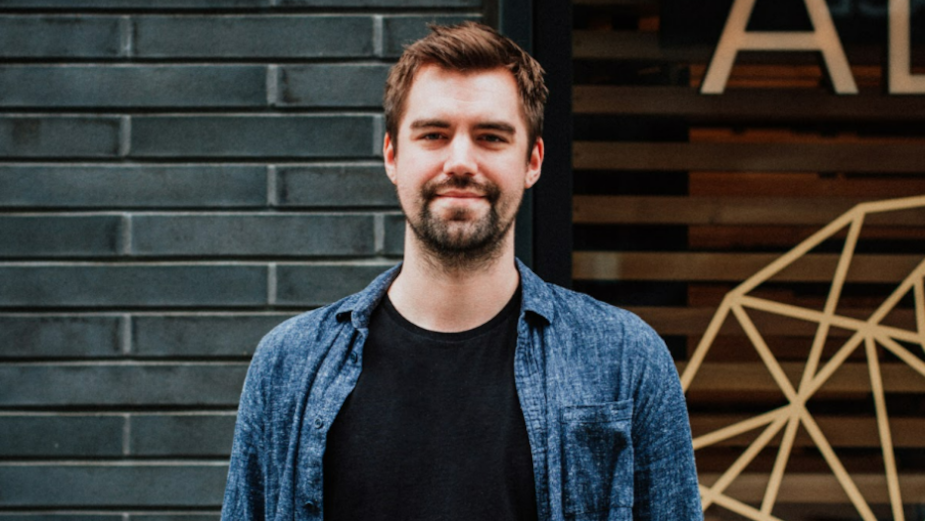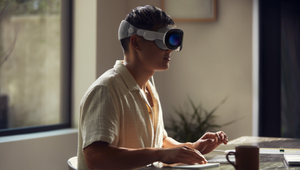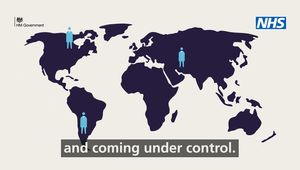
“I Want to Be Able to Tell My Daughter I Have Tried to Help the Planet”

Tom Dore is the global head of production and sustainability at Across the Pond. Through this role, he works with the agency’s teams around the world to focus on how the company can achieve its net-zero ambitions - helping everyone to understand that sustainability is no longer just a ‘production problem’ but something for everyone, everywhere to take action on.
He started his career in advertising as a runner and worked his way up through the ranks to become a freelance producer and production manager. During this time he has worked with big names including Universal, Condé Nast, YouTube, Google, Facebook, Carlsberg, Cartoon Network and Sony Music.
Tom is also a mentor with the Creative Mentor Network , an organisation which works with young people and creative professionals to help make the creative industries more socio-economically diverse. Through being a mentor, he has learned more about how unfair a career path can be and as a result, fosters a determination to help others develop skills and create their own opportunities.
When he’s not bolstering sustainability methods, Tom perseveres with his support of Norwich City F.C, cooking, and binge-watching Netflix with his fiancée and baby daughter.
Q> Can you tell us about your own personal journey when it comes to getting involved in sustainable production - how did you get started and where has that journey taken you?
Tom> When I was a runner at an ad agency at the beginning of my career, pitch and creative ideas were still mounted on 5mm polyfoam boards. Digital presentations were not considered serious enough. The client apparently liked to hold something in their hands.
Only after making thousands of those boards, most of which went straight into landfill after the pitch, did I learn that each one takes 450 years to decompose. It is a devastating fact that woke me up to the vast amounts of gross waste happening within agencies and on shoots.
As global head of production and sustainability for Across the Pond, I am committed to ensuring we become Net Zero by 2030. Personally, that objective has been further energised this year by becoming a Dad. It’s cliché but I want to be able to tell my daughter I have tried to help the planet.

Across the Pond’s 'Green Team' made up of volunteers from creative, production, marketing and post production teams.
Q> What are the conversations that clients are having with you about their desire to reduce the carbon footprint and environmental impact of their content production? (i.e. does it feel like there’s a high demand or does it vary from client to client)
Tom> Some clients are transparent from the outset about their desire to keep a production/project low impact, but presently, this is more the exception than the norm.
I think there is a disconnect between what the agency relations or procurement team asks of us regarding environmental credentials and the expectations of the average client/product manager.
While we are often asked to complete environmental questionnaires or undertake the Carbon Disclosure Project report on behalf of our clients, it’s not always clear how this bigger picture information filters into day-to-day project/product management.
I can’t yet think of a time when a client has come to us with clearly defined metrics of success relating to carbon emissions, and I’m not always sure if many are held to account or aware of the broader environmental targets or emissions of their organisation before speaking to us.
Q> Speaking generally, how do you tend to approach assessing and minimising the footprint of the productions you are involved in -and is this something that is built into your processes?
Tom> As of last year, we began using AdGreen’s carbon calculator to help us get closer to our carbon emissions. It's been a very helpful way of helping to contextualise the footprints of our key projects.
Our ultimate goal is to use this data so that we can talk to our clients about the carbon cost on every project in the same way we talk about the financial price. If we’re able to have real conversations from the outset, we stand a far better chance of making meaningful efficiencies throughout the entire project.
Q> To what extent do you think the advertising and production world will retain and build on the lessons learned during the pandemic?
Tom> Many people have talked about the pandemic as a reset button, and I think that’s true. However, I also see shrinking budgets and more scrupulous procurement teams as the main driver of change across the industry rather than the desire to reduce footprints.
Across The Pond has never been a particularly high-impact production company due to the nature of our work - we often use lean, doco-style crews rather than massive productions with hundreds of extras and huge set builds. We’ve also never been that production agency sending six EPs, account directors and the MD across the globe for an overseas jolly.
However, the remote technology that evolved during the pandemic has been a game-changer. It has allowed us to streamline further who we send on location or set. For us, it’s about finding the right balance between using the technology available and making sure you’re not short-changing on those who can deliver great work and troubleshoot any issues. After all, nothing multiplies a production’s footprint more than a re-shoot!
Q> What have you been finding are the most useful tools, resources and partners for reducing environmental impact/carbon footprint of productions?
Tom> AdGreen is a fantastic resource for production companies and creative departments. It was great to see AdGreen become an official part of the Advertising Association’s Ad Net Zero initiative. This felt like a major step in acknowledging that the impact of shoots is no longer just ‘production’s problem’ but our industry’s as a whole.
Similarly, Green the Bid is a super US-based resource for sustainable advertising production.
We’ve also brought on a great sustainability consultancy called Green Element to help us track our emissions with even more accuracy.
Q> How is sustainability being built into your training and development for members of the production team?
Tom> We lean heavily on AdGreen’s excellent resources to help onboard our team. Our creative and production teams (FT and freelancers) attend the two-hour AdGreen workshop, which is a superb way of engaging people with the broader concepts. It also helps them to understand that the project's footprint is effectively set at the brief stage, well before production might be involved.
New starters also have an onboarding session with me to better understand our net-zero goals and our general approach to sustainability, as well as the core things they can do to help us achieve from day one.
We have a Green Team that is integral to helping embed sustainability into our culture and everyday thinking far better than I can alone.
I’ve also been conscious to build sustainability goals into my team’s objectives and reviews.

Across the Pond team on a volunteer litter pick.
Q> At a recent Ad Net Zero event, Mark Read at WPP said that in total just 3% of the footage shot ends up on screen - does this signify huge wastage and the need for greater efficiencies in the production and craft or do you have other thoughts on this stat?
Tom> Wow, yes, that seems like a stark stat. Thinking back to some of my more painful 2am experiences on set; I wouldn’t necessarily contest it. This is an interesting conversation that ties into the thoughts of the APA on creating better working conditions. We’re talking about the waste of physical resources as well as people’s efforts and, ultimately, well-being. Something that hasn’t traditionally been a strength in the advertising production industry.
Q> Looking more broadly than carbon footprint, what are the other ways that production can be more sustainable?
There’s obviously lots to think about in terms of waste e.g. the single use plastics, gels, polyfoam, correx, carpentry materials that get use on sets on a daily basis.
Being clear to your suppliers about your desire to create a production that’s low-impact and beneficial to local communities is also key. There’s a huge knock on effect. The more we’re all asked to think about how we do business, the greater impact we’ll have as an industry.
Beyond the practical, consider how to demonstrate sustainable behaviours on screen as much as possible. Ad Net Zero and Purpose Disruptors offer some great guidance on things to consider e,g, showing reasonable portion sizes, people using electric cars, reusable bottles, and recycling on-screen.
Q> To what extent is the social or community impact of a production an important part of the sustainability conversation?
Tom> I think the social and community impact is hugely important in helping to move expectations and to change the norm’. The discussions that happen between takes or on lunch probably have a lot more impact in helping to shift what’s considered normal. A few years, I recall one of our PMs being taken to task by a gaffer for arranging a meat-free breakfast. I’m sure there are still a lot of crew who want meat in every meal, but the absence of it on set might not be called out in the same way!
The bigger picture is the potential ripple effect of production companies talking to their suppliers about greener solutions. That supplier then talks to their client, and so on. That’s going to be key in moving our industry to a low carbon future.

Across the Pond’s 'Greener Times' newsletter logo
Q> What advice would you give to anyone working in production, whether for a production company, agency or brand, who is struggling to get buy-in from their clients and colleagues on sustainable production?
Tom> Don’t be afraid to take the lead in the absence of any sustainability considerations from the clients’ side. Create a position of ‘this is how we do things’. It will be a rare client that pushes back on positive environmental suggestions.
Everyone talks about getting ‘buy-in’ from the top, but it’s true. Implementing new policies, making decisions and changing culture is significantly easier if you have buy-in from the company leadership.
Have a clear vision or overall vision/goal/mission that you are working towards. I saw a big change in enthusiasm when we set becoming net-zero as a goal. It’s more ambitious and a huge challenge but it’s a clear, tangible goal.
Keep your colleagues up to date with progress. Share data, even small tidbits. Constantly talking about progress helps contextualise and normalise things for your wider team.
Finally, driving long-term sustainable changes can be frustrating. The results are not always immediate. Surround yourself with people who keep you motivated. Our Green and BCorp teams are full of fun, creative, ‘possibility’ thinkers, and they are a key asset in bringing the agency along with us. They’ve helped me to create more engaging ways of communicating our net-zero and sustainability to the wider company, e.g.. creating our internal green newsletter ‘The Greener Times’. Recently, we also created and hosted a Net-Zero gameshow (complete with opening titles!) for the whole agency to communicate our current footprint and net-zero mission.















